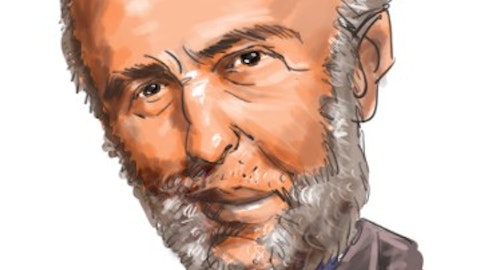The best performing big bank stock so far this month might be a surprise, with the surprise winner being Citigroup (NYSE:C), up over 6% so far this month. Another surprise, of the five stocks we consider the dominant banks, Citi is up the second most year-to-date at 32%. When thinking about the top big bank stocks, the others that come to mind include Wells Fargo & Company (NYSE:WFC), JPMorgan Chase & Co. (NYSE:JPM), Bank of America Corp (NYSE:BAC), and U.S. Bancorp (NYSE:USB).
When looking at the balance sheets and market dynamics of some of the large banks, it is clear that Wells Fargo and U.S. Bancorp have some of the strongest balance sheets. These two companies are primarily focused on U.S. operations, versus the other three who have more European exposure. Citigroup has been the biggest laggard since 2009, but is it time for a breakout?
The hedge fund interest and activity in Citi is the least of all the five banks, and the top two fund owners by shares held their positions steady during 2Q, Eton Park Capital and Jabre Capital Partners. Yet, the company continues to see solid price performance with the buildup of capital, and planned return of capital to shareholders in 2013 in the form of buybacks and dividend increases. Citi revenues are expected to be up 3.5% in 2012 and EPS up 22% in 2013.
While Citigroup is up the most this month, the only bank up more year-to-date is Bank of America, up 66%. Bank of America is a favorite of Bruce Berkowitz in preparation for QE3. Berkowitz owned over 100 million shares at the end of 2Q, which represented over 12% of his firm’s 2Q 13F portfolio. Although the bank is up the most year-to-date, Bank of America recently saw 3Q estimates cut by S&P, to a loss of $0.07 per share from $0.21 due to continued weakness in Europe.
JPMorgan has seen a nice recovery from the Libor scandal and trading loss, up over 30% from its summer low. The trading loss has come in at $6.0 billion so far, but its core business looks strong, with robust 1.0% loan growth from 1Q and a decline in net charge offs. JPMorgan calls Lansdowne Partners its largest fund shareholder with over 18 million shares and almost 12% of the firm’s 13F portfolio invested in the company. JPMorgan also saw a number of insider purchases by Jamie Dimon in the range of $34-$34.50 back in July—see our thoughts on whether Dimon should sell now. JPMorgan continues to be one of the stronger banks as it sees declines in net charge offs, expected to be $9 billion for 2012, compared to 2011’s $12.2 billion, while EPS is expected to grow 5.6% on the back of declining provisions for credit losses.
Many of the other banks rely more heavily on investment banking profits, while Wells Fargo and U.S. Bancorp have been able to grow earnings thanks the surge in mortgage refinancing. Wells Fargo continues to focus on cross-selling and driving revenue with refinancing business. We see a decline in Wells’ ability to continue to cross-sale, especially as the opportunities to cross-sale to former Wachovia customers wears off. Even so, Wells is still owned by top manager Warren Buffett. Buffett had almost 20% of his 13F portfolio invested in Wells at the end of 2Q. Also, Ken Fisher and D.E. Shaw are other notable owners.
The fifth largest bank by assets, U.S. Bancorp, is expected to see interest income up 5.3% in 2012, better than most peers. USB is expected to continue to see strong fundamentals—considered to have the best fundamentals of all the banks in terms of loan growth, credit quality, allowance coverage and low non-interest expenses. At the end of 2Q, nonperforming loans fell 19% from year-end 2011, a better-than-peers decline. Warren Buffett also owned the most shares of U.S. Bancorp of any of the funds we track at the end of 2Q, with Bancorp making up almost 3% of Buffett’s 13F portfolio.
We believe that Citi has a long way to go with respect to international growth, but the company does trade at a discount relative to its peers and could be a buy at current levels, in addition to Bank of America. Citi and Bank of America trade below its peers on a P/E and a P/B basis—both Citi and Bank of America have P/B ratios below 1.0. The other ‘strong’ banks trade at elevated P/B levels, with U.S. Bancorp trading at a 2.0 and Wells at a 1.4. Also worth noting is that all the other banks pay a dividend yield above 2%, while Citi and Bank of America pay very low yields, but have plans to increase returns to shareholders in the coming year.
For a continued look at the hedge fund industry’s sentiment toward the U.S.’s big banks, continue reading here.






